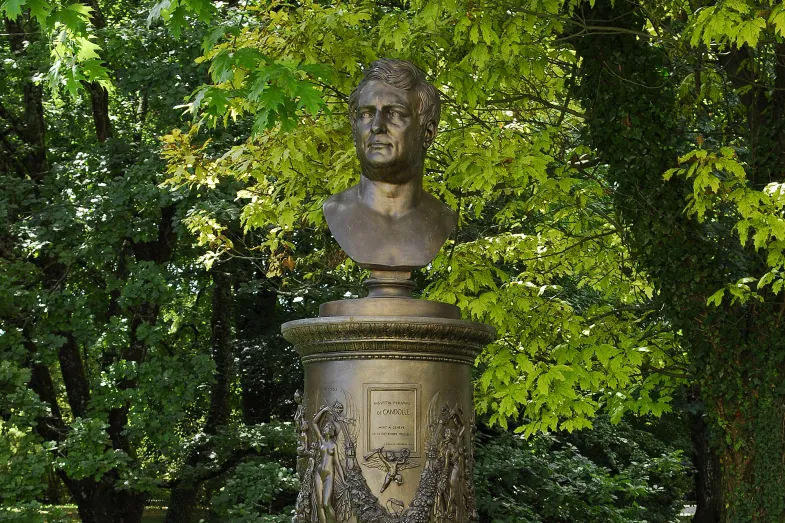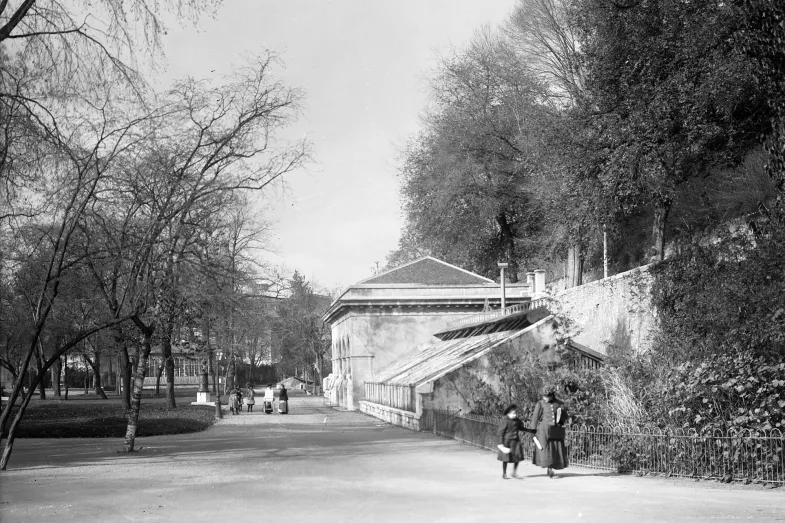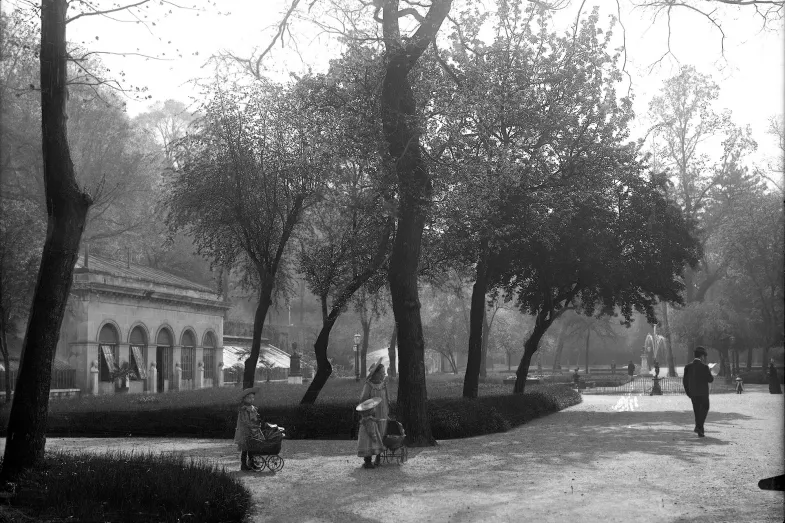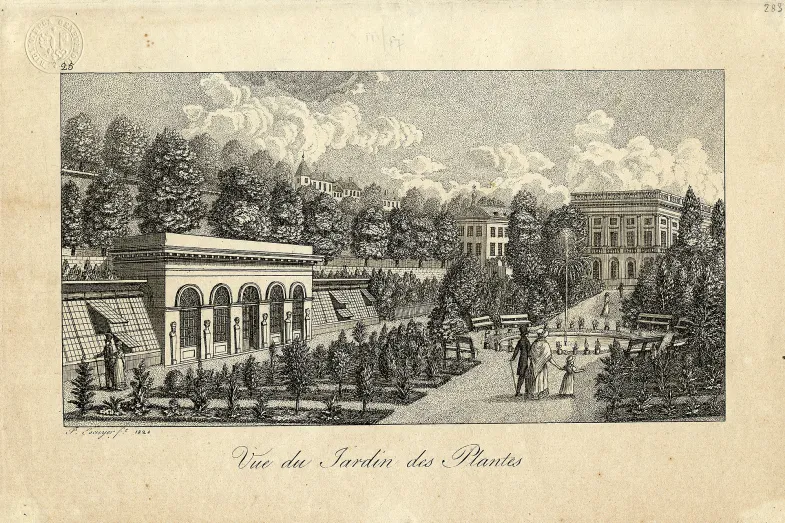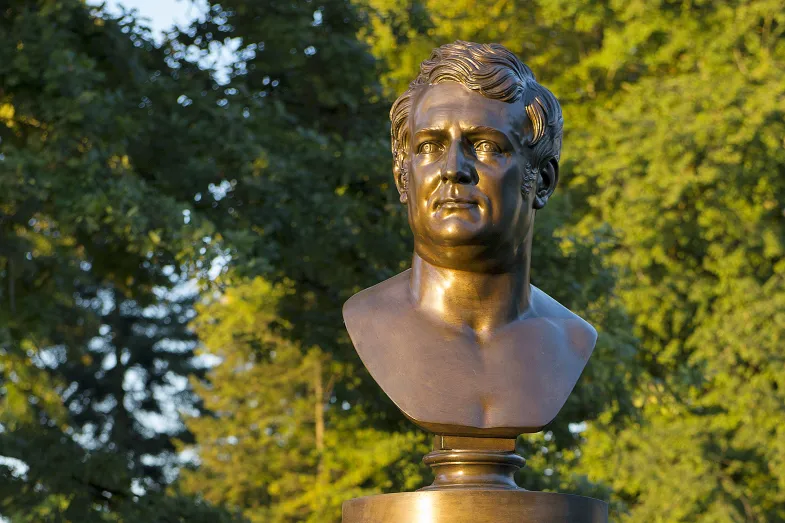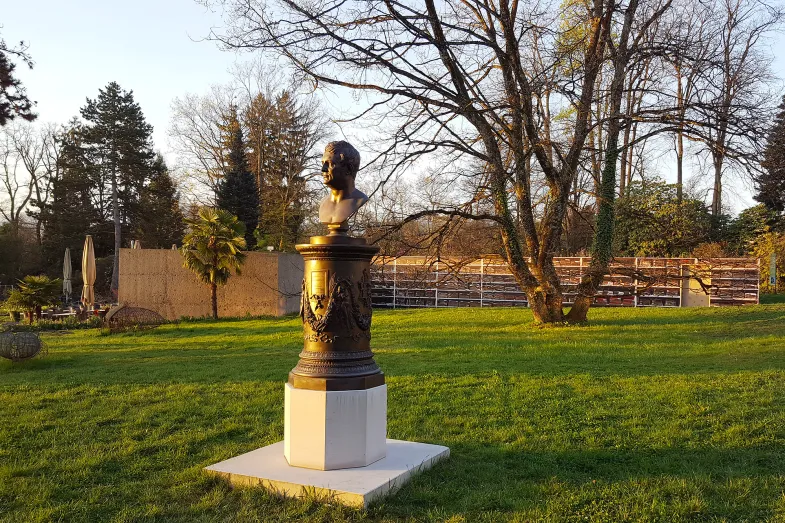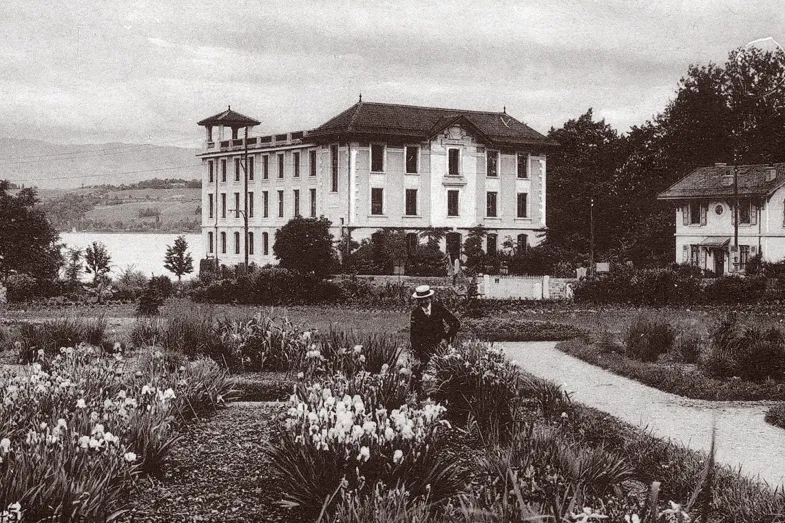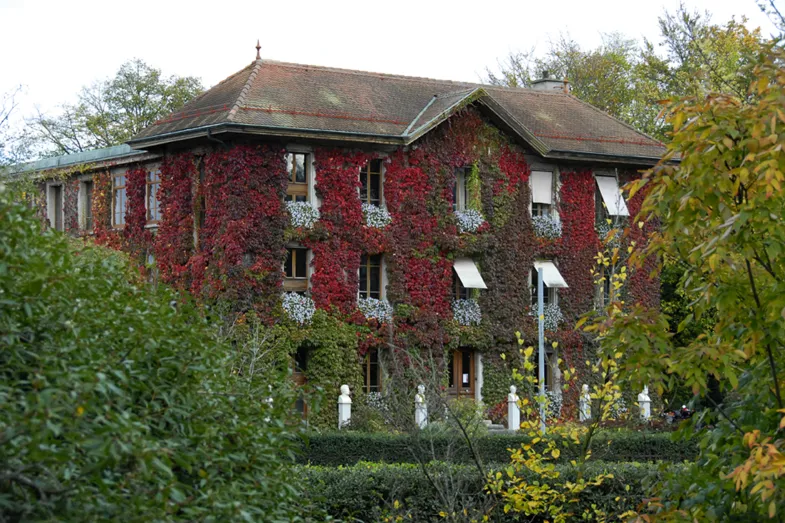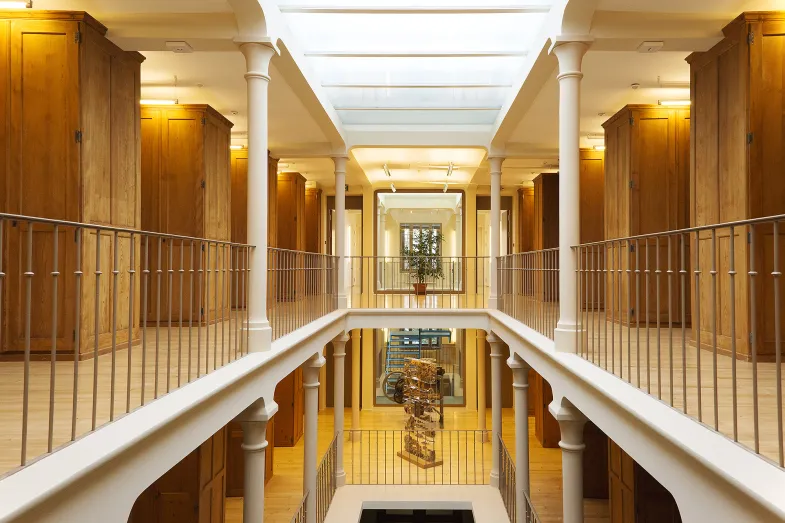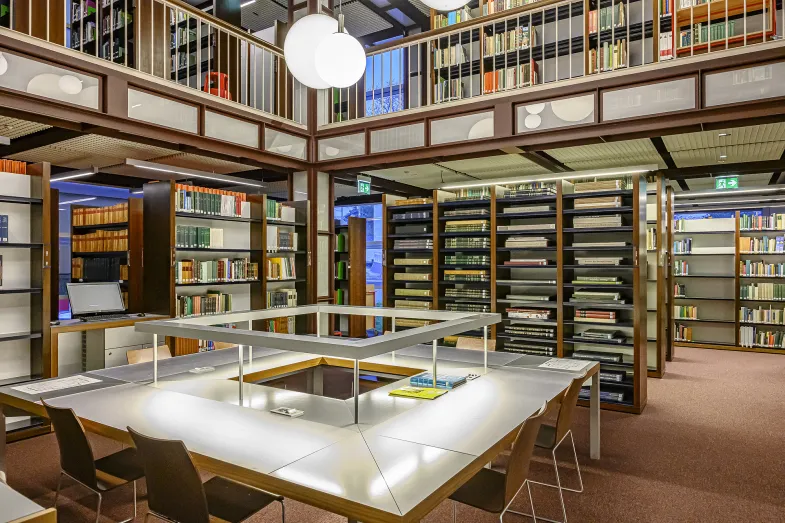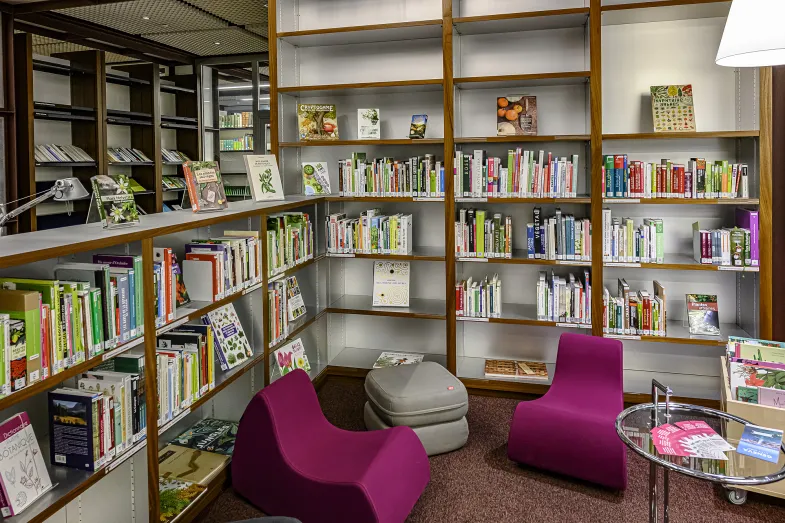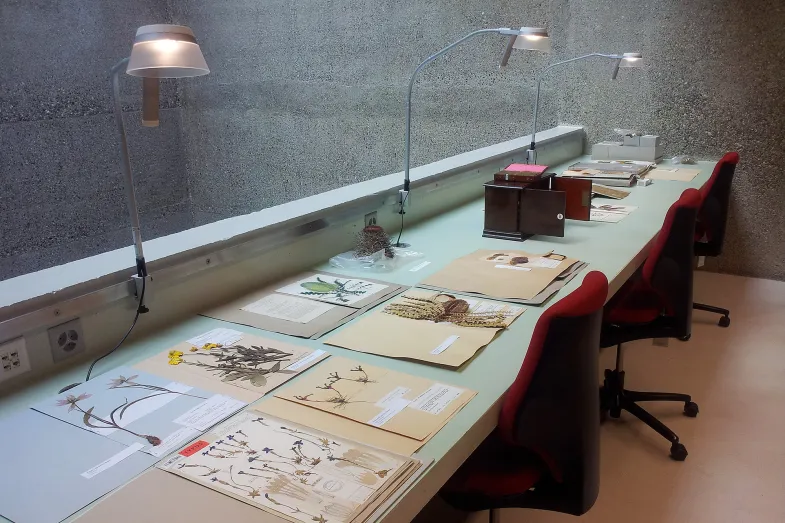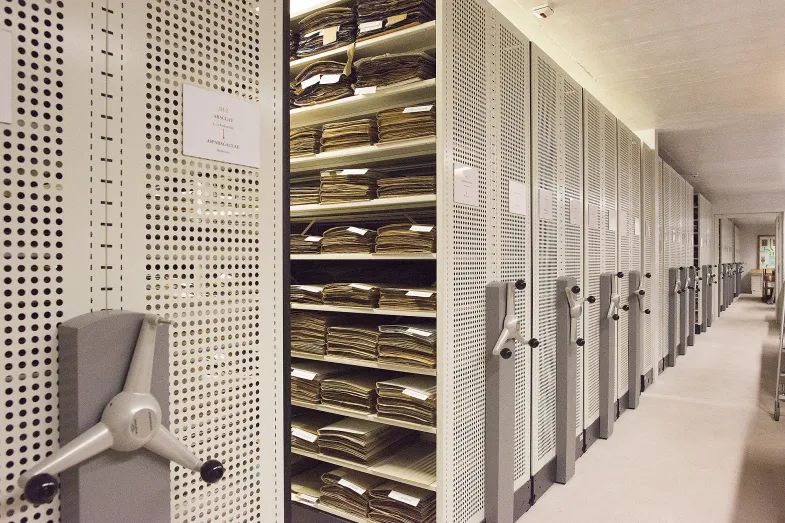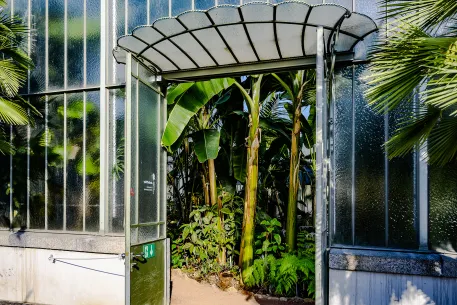The Botanical Garden of Geneva: 200 years of history
200 years of history
It is to the Geneva botanist Augustin-Pyramus de Candolle (1778-1841) that we owe the creation of the Botanical Garden of Geneva, in 1817. Over 200 years of milestones.
Very quickly cramped in the heart of the city
Initially situated in the heart of Geneva, at the foot of the ramparts of the old town in the current Parc des Bastions, the garden moved to gain more space. In 1904, a building was constructed on the site called La Console to house the herbaria and the library. The Botanical Garden then covered an area of 7.5 hectares in the Parc de l’Ariana.
Gradual construction
In 1908 and 1911 the greenhouses and orangery were built.
Between 1954 and 1978 the garden grew to 18 hectares by acquiring neighbouring properties. Today you can walk through 28 hectares of nature, a stone’s throw from the city and the lake.
In 1971 and 1974 new buildings were erected to house two-thirds of the collection of herbaria and all of the library.
A commitment taken up with enthusiasm
For 200 years the Conservatory and Botanical Garden of Geneva (CJBG) have pursued their mission with dedication, following in the footsteps of the founders.
The aim is to explore the botanical heritage by conducting scientific research projects.
Conserving species, whether alive in the garden or dried in the herbarium.
Researching and advancing knowledge of the plant world, particularly through systematics, floristics and population genetics.
Transmitting the knowledge acquired by observing the botanical heritage: issuing various publications, presenting collections and themed exhibitions. Instruction is available for different audiences: trainees, apprentices or people completing their civilian service in the garden; academics in cryptogamic, phanerogamic or systematic research laboratories; school students and the wider public interested in themed guided tours or awareness workshops.
Protecting the plant world in three ways: establishing a red list of endangered species to then collect and multiply endangered species, and providing solutions for invasive species. Communicating enthusiasm for the plant world and raising awareness of the fragility of species, so as to contribute to the overall momentum for protecting nature.
A garden, concentrated nature and a research tool
The CJBG offers its many visitors a place of beauty and relaxation, of awareness for the conservation of nature that is too often threatened, all while carrying out many regional, national and international research programmes using the most modern techniques (satellite remote sensing, molecular biology, territorial information systems, in vitro cultivation, automated DNA sequencing) for these investigations.
Très vite à l’étroit en pleine ville
Tout d’abord situé au cœur de Genève, au pied des remparts de la vieille-ville, dans l’actuel parc des Bastions, ce jardin déménage pour gagner en espace. En 1904, on construit un bâtiment au lieu-dit La Console pour abriter les herbiers et la bibliothèque. Le jardin botanique s’étend alors sur une surface de 7,5 hectares dans le parc de l’Ariana.
Une construction progressive
En 1908 et 1911, on construit les serres et l’orangerie.
Entre 1954 et 1978, le jardin s’agrandit à 18 hectares, grâce à l’acquisition des domaines voisins. Aujourd’hui, on peut se promener sur 28 hectares de nature, à deux pas de la ville et du lac.
En 1971 et 1974, de nouveaux bâtiments sont édifiés pour accueillir les deux tiers de la collection d’herbiers et toute la bibliothèque.
Un engagement relayé avec enthousiasme
Depuis deux cents ans, les Conservatoire et Jardin botaniques de Genève (CJBG) poursuivent leurs missions, dans la continuité des fondateurs, avec engagement.
Il s’agit d’explorer le patrimoine botanique en menant des projets de recherche scientifique.
Conserver les espèces, qu’elles soient vivantes dans le jardin ou séchées dans les herbiers.
Rechercher et faire évoluer les connaissances du monde végétal, en particulier en systématique, floristique, et génétique des populations.
Transmettre les connaissances acquises par l’observation du patrimoine botanique: publications diverses, présentation des collections et expositions thématiques. L’enseignement se décline pour divers publics: stagiaires, apprentis ou civilistes actifs au jardin; universitaires dans les laboratoires de recherche en cryptogamie, phanérogamie ou systématique; les écoliers et le grand public intéressés par des visites guidées à thèmes ou ateliers de sensibilisation.
Protéger le monde végétal en trois axes: établir des listes rouges d’espèces en danger pour ensuite récolter et multiplier les espèces menacées, apporter des solutions pour les espèces envahissantes. Communiquer son enthousiasme pour le monde végétal et éveiller les consciences aux fragilités des espèces, afin de contribuer à l’élan général pour la protection de la nature.
Un jardin, concentré de nature et outil de recherche
Les CJBG offrent à leurs nombreux visiteurs un espace de beauté et de détente, de sensibilisation à la conservation d’une nature trop souvent menacée, tout en menant de nombreux programmes de recherche régionaux, nationaux ou internationaux, utilisant pour leurs investigations les techniques les plus modernes (télédétection satellitaire, biologie moléculaire, systèmes d’information du territoire, culture in vitro, séquençage automatique d’ADN).
La bibliothèque des CJBG
The CJBG library
Researchers and those with an interest have easy access to this outstanding resource collection covering the majority of botanical and mycological subjects.
Are you interested in the classification and description of organisms, biogeography, ecology, ethnobotany, horticulture, physiology and molecular biology? A number of works relate to flora and taxonomic studies, as well as the history of botany. A wide range of popular books completes this collection.
The library also owns wonderful pre-Linnean works from the 16th and 17th centuries and a remarkable series of folio and botanical quartos dating from the 18th century, most of them richly decorated with engravings. This exceptional heritage bears witness to Geneva’s long botanical tradition.
A collection which has grown over the years
In its early days (in 1824), the library of the Botanical Conservatory was modest, and it remained so throughout the 19th century. A few acquisitions, donations and legacies only slowly increased the initial collection. Its real development dates from the beginning of the 20th century, more specifically 1920, when the Vaud botanist Emile Burnat bequeathed to the City of Geneva his prestigious botanical library of 3,000 volumes, which itself contained part of the collections of Louis Leresche, Samuel Bridel and Judge Abraham Thomas. Shortly thereafter, the Rockefeller foundation contributed to the acquisition of new items.
In 1921, the famous de Candolle library was in turn donated by the family of the last botanist of that name. This wonderful family collection is worthy of comparison with those of the great national museums. Another valuable element to be added to the Conservatory was the Boissier library, permanently donated in 1943 by the university, which had received it through the generosity of the Boissier family. Subsequently the library was able to acquire useful additions such as the libraries of the Geneva Botanical Society and the Geneva Horticultural Society, as well as the old collections of the university’s Institute of General Botany and Laboratory of Pharmacognosy and Galenic Pharmacy. At the end of the 1970s, the extensive library of Paul Aellen joined the collection.
Since then the City of Geneva, the guardian of these riches, has provided regular credits to keep the library up to date through acquisitions.
Networked resources
A free access area allows consultation of a part of the collection selected for an introduction to botany. Since December 2020 the CJBG library has been part of the new Swiss Library Service Platform SLSP (swisscovery), after 36 years of working with the Library Network of Western Switzerland (RERO). This modernised research portal brings together 500 Swiss scientific libraries totalling 30 million works.
The CJBG herbaria
With six million or so specimens, the CJBG herbarium is one of the most important in the world. It stands in a long tradition of botany in Geneva dating back to the 18th century and contains plants and fungi from the whole world, but in particular those of the Mediterranean, the Near and Far East, South America and European flora.
The herbarium is not open to the public, however group visits are organised several times a year during scheduled guided tours.
History of the CJBG herbarium collection
The history of the general collection starts with the donation of the Haller filius herbarium in 1823, but it is with the arrival of the Benjamin Delessert herbarium in Geneva in 1869 (300,000 specimens from the entire world) that the Botanical Conservatory acquires real international status. Many collections were then added to the general collection, which has continued to grow through exchanges, donations and acquisitions, as well as items gathered by the institution’s botanists. Among the more important collections that have been added to the general herbarium are:
Phanerogamic
P. Aellen; W. Barbey; P.E. Boissier; A.P. de Candolle; A.L.P.P. de Candolle; A.C.P. de Candolle; E. Hassler; W.G.F. Herter; A. Huber-Morath; R.V. Litardière; G. Looser; P. Mouterde; H. Pabot; K.H. Rechinger; G.F. Reuter.
Cryptogamic
J.J. Brun (Diatoms); A.P. De Candolle; J.-E. Duby (Musci); J. Favre (Basidiomycetes); V. Fayod (Basidiomycetes); A.L.A. Fée (lichenised Ascomycetes); K.W.G.L. Fuckel (Ascomycetes); J. Hedwig (Musci); J.B. Jack (Hepaticae); M. Josserand (Basidiomycetes); R. Kühner (Basidiomycetes); J. Müller Argoviensis (lichenised Ascomycetes); C.G.D. Nees (Musci); L.E. Schaerrer (lichenised Ascomycetes); F. Stephani (Hepaticae).
“Closed” herbaria
These generally correspond to a work of reference by which they are classified and in an order which is immutable. The specimens in these collections are not loaned. However, to make them accessible to as many people as possible, the CJBG has computerised the herbaria specimens (digitising the information contained on the labels and scanning the specimens); all this information is centralised in the Botanical Information System of Geneva (SIBG). In the long term, the SIBG will be replaced by a new, open source tool: BOTALISTA.
G-DC (the de Candolle herbarium): this not only includes the materials used during the drafting of the Prodrome but also those of the Monographiae Phanerogamarum (the other series from the de Candolle herbarium has been incorporated into the general herbarium (G)).
G-BOIS (Flora Orientalis): this herbarium was recreated during the 1960s, on the basis of the materials cited in the Flora Orientalis (the other collections of the Boissier herbarium are incorporated in the general herbarium (G)).
G-BU (Burnat herbarium): comprises a herbarium of the Maritime Alps, a herbarium of Europe (comprising the series collected by John Briquet and used for his Prodrome of Corsican Flora) and the Thuret herbarium.
G-PREL (Pre-Linnean collection): Collection of the herbaria of the Burmans father and son and Houttuyn, extracted from the general herbarium since 1992, consisting of approximately 30,000 ancient specimens and including collections from the 17th and 18th centuries, notably collected from India, Ceylon, the Cape of Good Hope and the Antilles.
Avec ses quelque 6 millions d’échantillons, l’herbier des CJBG est l’un des plus importants au monde. Héritier d’une longue tradition botanique genevoise qui remonte au XVIIIe siècle, il rassemble des végétaux et des champignons du monde entier, mais surtout de la région méditerranéenne, du Proche- et Moyen-Orient, d’Amérique du sud et de la flore européenne.
L’herbier n’est pas ouvert au public, mais des visites de groupes sont organisées plusieurs fois par an lors des visites guidées programmées.
Histoire de la collection d’herbiers des CJBG
L’histoire de la collection générale débute avec le don de l’herbier Haller filius, en 1823, mais c’est avec l’arrivée à Genève de l’Herbier Benjamin Delessert en 1869 (300’000 spécimens du monde entier) que le Conservatoire botanique acquiert une véritable stature internationale. De nombreuses collections viennent ensuite augmenter la collection générale dont l’accroissement se poursuit, par échanges, dons et achats, et par les récoltes des botanistes de l’institution. Parmi les plus importantes collections qui sont venues s’ajouter à l’Herbier général on peut citer:
Phanérogamie
P. Aellen; W. Barbey; P. E. Boissier; A. P. de Candolle; A. L. P. P. de Candolle; A. C. P. de Candolle; E. Hassler; W. G. F. Herter; A. Huber-Morath; R. V. Litardière; G. Looser; P. Mouterde; H. Pabot; K. H. Rechinger; G. F. Reuter.
Cryptogamie
J. J. Brun (Diatomées); A. P. De Candolle; J.-E. Duby (Musci); J. Favre (Basidiomycètes); V. Fayod (Basidiomycètes); A. L. A. Fée (Ascomycètes lichénisés); K. W. G. L. Fuckel (Ascomycètes); J. Hedwig (Musci); J. B. Jack (Hepaticae); M. Josserand (Basidiomycètes); R. Kühner (Basidiomycètes); J. Müller Argoviensis (Ascomycètes lichénisés); C. G. D. Nees (Musci); L. E. Schaerrer (Ascomycètes lichénisés); F. Stephani (Hepaticae).
Herbiers « fermés »
Ils correspondent en général à un ouvrage de référence selon lequel ils sont classés et dont l’ordre est immuable. Les échantillons de ces collections ne sont pas prêtés. Néanmoins, pour les rendre accessibles au plus grand nombre, les CJBG ont informatisé des échantillons d’herbiers (numérisation des informations contenues sur les étiquettes et scannage des spécimens), toutes ces informations étant centralisées dans le Système d’Informations Botanique de Genève (SIBG). À terme, le SIBG est destiné à être supplanté par un nouvel outil, open source: BOTALISTA.
G-DC (Herbier de Candolle): cet herbier comprend non seulement les matériaux utilisés lors de la rédaction du Prodrome, mais aussi ceux des «Monographiae Phanerogamarum» (les autres séries de l’Herbier De Candolle ont été incorporées dans l’Herbier général (G)).
G-BOIS («Flora Orientalis»): cet herbier a été reconstitué dans les années 1960, sur la base des matériaux cités dans le «Flora Orientalis» (les autres collections de l’Herbier Boissier sont incorporées à l’Herbier général (G)).
G-BU (Herbier Burnat): comprend un «Herbier des Alpes maritimes», un herbier d’Europe (comprenant les séries récoltées par John Briquet et utilisées pour son Prodrome de la Flore Corse) et l’herbier Thuret.
G-PREL (Collection prélinnéenne): Collection des herbiers Burman père et fils et Houttuyn extraite de l’herbier général depuis 1992 d’environ 30’000 spécimens anciens et comprenant des récoltes des XVIIe et XVIIIe siècles faites notamment dans les Indes, à Ceylan, au Cap de Bonne Espérance et dans les Antilles.

